Whip cream, with its light, airy texture and delicious taste is an excellent accompaniment to an array of desserts. But anyone who’s tried making it at home will know the speed at which it loses the volume of it and end up becoming watery. It is particularly difficult in the event that you wish your desserts to remain in their original form for an extended period of time. Stabilizing the whipped cream is crucial element to preserving its fluffy appearance, and it’s much simpler than you imagine.
The first step to stabilizing whipped cream is understanding how it is that it doesn’t work in the first place. Since whipped cream is prepared by beating air to create cream The fat contained in the cream binds those air bubbles. But, as time passes the bubbles begin to combine and collapse and cause the cream to shrink in volume. This process is accelerated by heating and also by the natural tendency of the liquid in cream to break away from the fat. In order to stop this, a variety of stabilizers can be introduced to provide the cream with structure and help it hold to the air bubbles.
However, what happens to long-term stability? The stabilizers are the ones that come into their role. The most common stabilizers are powdered sugar, cornstarch and gelatin. It is also a source of cornstarch that helps to absorb water, and also prevents tears. Cornstarch, used directly, has a similar effect and is especially beneficial for those who require an option that’s gluten-free. Gelatin is, on the other is a much more complex network within the cream that holds air bubbles together. Gelatin is the ideal stabilizer for a cream that needs to last for a long time in hot weather or under the lights of an event with food photography.

An additional stabilizer to consider can be found in gelatin. Gelatin is particularly useful and Make whipped cream last longer is required to last for an extended period of time and in hot conditions. Gelatin can be applied by sprinkling a small amount over cold water and let it set for about a minute. It is then a matter of heating your mixture until the gelatin disintegrates completely. Let it cool down to room temperature before gradually pouring it into your almost fully whipped cream. Gelatin helps strengthen the structure of the whipped cream, which makes it more stable.
Another aspect of stabilizing whipped cream is the climate in which it’s stored. Cream that is whipped prefers cold temperatures thus it should always be kept in the refrigerator until it’s ready to be used. If you’re serving it in the outdoors or in a warm space consider placing your dessert bowl on a bed of ice to keep the cream cool. Consider the type of surface that you’re spreading the cream on. Wet or humid desserts could seep into whipping cream and cause it to expand. The process of allowing the dessert to fully cool or forming the barrier by covering it with a layer of sugar icing can prevent this.
In the end, the placement and storage of your stabilized whipped cream is equally important as the process of making it. Always apply whipped cream with delicate touch. Use the spoon or piping bag to apply it to your desserts. Be careful not to overhandle or press down as this can create bubbles that are too large and make the cream lose its volume. For storage, keep the chilled cream as cool as possible without freezing it. Utilize it within the first few hours after preparing, or if you’ve used a strong stabilizer such as gelatin, it might last for up to a day.